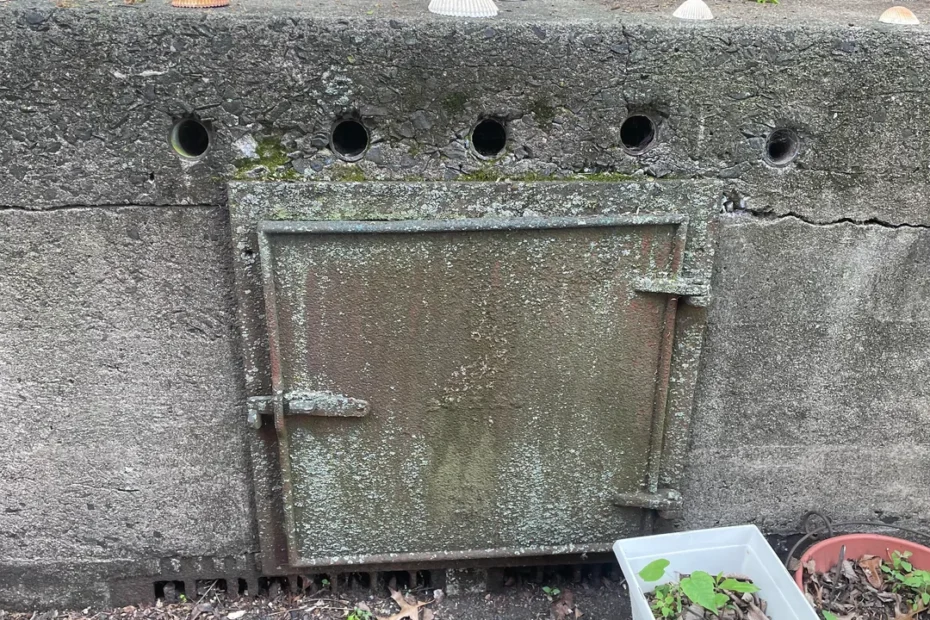A questioner said:
Large iron furnace next to my 1900’s house! What is this?
My best guess is an incinerator? It looks like the pipe opening on top and in the front could be configured different ways. The piece on top Isn’t attached by was found with it.




More from the owner:
I always thought it was an oven or something to heat the house, but now I’m thinking it was for trash.
Some of the people opinions on it:
1. If that old ‘garbage receiver’ topper is covering a stovepipe-sized vent i think your best bet is a trash incinerator.
2. My bad my mind went to outside outhouse
3. I would want to use this as a bbq somehow…
4. Whatever it was it would make a cool bbq/pizza oven.
5. With the pipes coming out, my guess is it heated water.
6. Maybe a greenhouse heater for a greenhouse that is no longer there
7. It’s a garage pit. People used to have to separate garage(what rots) from other trash and put it in a hole to rot and ultimately be slurped up by a pump
8. Trash Incinerator.
9. Did you try googling the names cast in the top? Looks interesting.
10. Try burning something in it.
11. Lol, that is a very old outdoor grill made out of concrete. Look at all of the ventilation above the opening and the built-in grate on the bottom. Or a trash incinerator, though I can’t see attaching one to the house.
12. Coal bunker.
What do you think? Let us know in the comment!
Read Also: Does anyone know what this is? It is over the basement door in our 1890’s home.
In the backyard of my 1900s-era house stands a relic from a bygone era—a large iron furnace. This imposing structure, once a powerhouse of industry, now serves as a poignant reminder of the region’s industrious past and a unique historical feature in my everyday life.
The Historical Significance
Iron furnaces played a crucial role in the industrial development of many regions in the late 19th and early 20th centuries. These furnaces were the heart of ironworks, where raw materials like iron ore, limestone, and charcoal were transformed into molten iron. This iron would then be cast into a variety of products, from building materials to household goods, fueling the growth of burgeoning towns and cities.
The iron furnace next to my home likely dates back to this industrial boom. During its operational years, it would have been a hub of activity, with workers laboring around the clock to keep the fires burning and the iron flowing. The furnace not only contributed to the local economy but also shaped the social fabric of the community, providing jobs and fostering a sense of shared purpose.
Architectural and Engineering Marvel
Standing next to this iron furnace, it’s hard not to be impressed by its sheer size and the ingenuity of its construction. Built primarily from locally sourced stone and brick, the furnace’s robust structure has withstood the test of time. Its towering chimney and large hearth area are testaments to the advanced engineering skills of the era. These furnaces were designed to operate at incredibly high temperatures, a feat that required careful planning and precise execution.
The architecture of the furnace also reflects the aesthetic sensibilities of the period. Despite its industrial purpose, the furnace exhibits a certain rugged beauty, with its weathered stones and rusted ironwork creating a striking visual contrast against the surrounding landscape.
Living with History
Living next to such a significant historical artifact has its unique charm and challenges. On one hand, the furnace adds a distinctive character to my property. It sparks curiosity and admiration from visitors, and it’s a tangible link to the past that few people have the privilege to experience so intimately.
However, maintaining and preserving this piece of history is a responsibility I take seriously. Over the years, I’ve undertaken various preservation efforts to ensure the furnace remains in good condition. This includes periodic cleaning, structural assessments, and, occasionally, working with local historical societies to access expert advice on preservation techniques.
Community and Educational Value
The iron furnace is not just a personal treasure but also a valuable educational resource for the community. I’ve hosted several tours and educational sessions for local schools and history enthusiasts, offering them a glimpse into the region’s industrial heritage. These events have been incredibly rewarding, as they foster a greater appreciation for local history and inspire younger generations to value and preserve their heritage.
Additionally, the furnace has become a focal point for community gatherings. Annual events like historical reenactments and heritage festivals often center around the furnace, drawing crowds and celebrating the rich history it represents. These gatherings not only provide entertainment but also strengthen community bonds and keep the stories of our past alive.
The Future of the Iron Furnace
As I look to the future, I am committed to continuing the preservation of the iron furnace. I hope to secure official recognition for its historical significance, which could provide access to additional resources and expertise for its maintenance. Collaborating with local historical societies and engaging the community in preservation efforts will be crucial to ensuring that this remarkable structure remains a proud testament to our industrial heritage for generations to come.
In conclusion, the large iron furnace next to my 1900s house is more than just an old industrial relic. It is a symbol of a bygone era, a marvel of engineering, and a cherished part of the local community. Living alongside this silent giant has deepened my appreciation for history and inspired a commitment to preserving the past, ensuring that the legacy of the iron furnace endures for many years to come.
